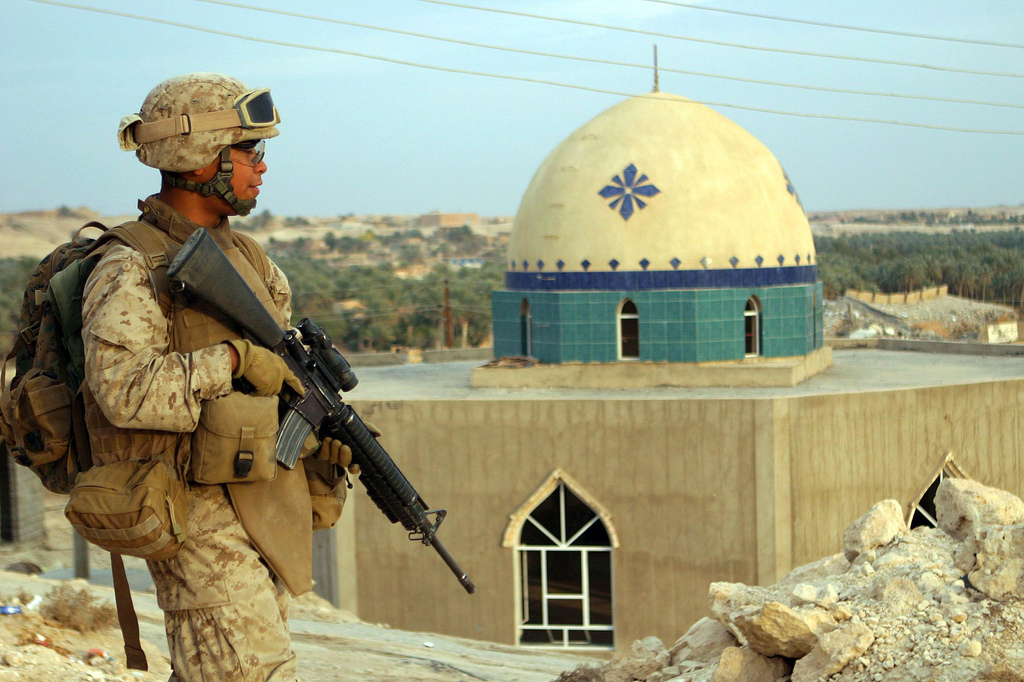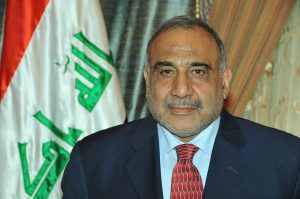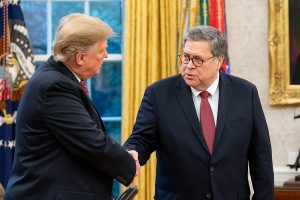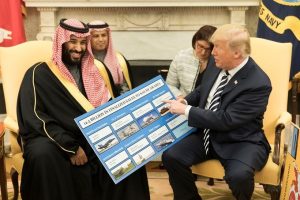by Nick Turse
There’s good news coming out of Iraq… again. The efforts of a 65-nation coalition and punishing U.S. airstrikes have helped local ground forces roll back gains by the Islamic State (IS).
Government forces and Shiite militias, for example, recaptured the city of Tikrit, while Kurdish troops ousted IS fighters from the town of Sinjar and other parts of northern Iraq. Last month, Iraqi troops finally pushed Islamic State militants out of most of the city of Ramadi, which the group had held since routing Iraqi forces there last spring.
In the wake of all this, Secretary of Defense Ashton Carter touted “the kind of progress that the Iraqi forces are exhibiting in Ramadi, building on that success to… continue the campaign with the important goal of retaking Mosul as soon as possible.” Even more recently, he said those forces were “proving themselves not only motivated but capable.” I encountered the same upbeat tone when I asked Colonel Steve Warren, a U.S. military spokesman in Baghdad, about the Iraqi security forces. “The last year has been a process of constructing, rebuilding, and refitting the Iraqi army,” he explained. “While it takes time for training and equipping efforts to take effect, the increasing tactical confidence and competence of the ISF [Iraqi security forces] and their recent battlefield successes indicate that we are on track.”
“Progress.” “Successes.” “On track.” “Increasing tactical confidence and competence.” It all sounded very familiar to me.
By September 2012, after almost a decade at the task, the U.S. had allocated and spent nearly $25 billion on “training, equipping, and sustaining” the Iraqi security forces, according to a report by the Special Inspector General for Iraq Reconstruction. Along the way, a parade of generals, government officials, and Pentagon spokesmen had offered up an almost unending stream of good news about the new Iraqi Army. Near constant reports came in of “remarkable,” “big,” even “enormous” progress for a force that was said to be exuding increasing “confidence,” and whose performance was always improving. In the end, the U.S. claimed to have trained roughly 950,000 members of the “steady,” “solid,” Iraqi security forces.
And yet just two and a half years after the U.S. withdrawal from Iraq, that same force collapsed in spectacular fashion in the face of assaults by Islamic State militants who, by CIA estimates, numbered no more than 31,000 in all. In June 2014, for example, 30,000 U.S.-trained Iraqi troops abandoned their equipment and in some cases even their uniforms, fleeing as few as 800 Islamic State fighters, allowing IS to capture Mosul, the second largest city in the country.
Blaming the Victim
“When U.S. forces departed Iraq in 2011, it was after helping the Iraqi government create an entirely new Iraqi Security Force following the fall of Saddam Hussein’s regime,” Major Curtis Kellogg, a spokesman with U.S. Central Command, explained to me last year. It almost sounded as if the old regime had toppled of its own accord, a new government had arisen, and the U.S. had generously helped build a military for it. In reality, of course, a war of choice — based on trumped up claims of nonexistent weapons of mass destruction — led to a U.S. occupation and the conscious decision to dissolve Iraqi autocrat Saddam Hussein’s military and create a new army in the American mold. “[T]he Iraqi security forces were a fully functioning element of the Iraq Government,” Kellogg continued, explaining how such an Iraqi military collapse could occur in 2014. “However, the military standards established and left in place were allowed to atrophy following the departure of U.S. troops.”
More recently, Colonel Steve Warren brought up another problem with Iraq’s forces in an email to me. “The Iraqi army that we left in 2011 was an army that had been trained for counterinsurgency. That means route clearance, checkpoint operations, and IED [improvised explosive device] reduction, for example. The Iraqi army that collapsed in 2014 was… not trained and… not ready for a conventional fight — the conventional assault that ISIL brought to Mosul and beyond.”
Both Kellogg and Warren stopped short of saying what seems obvious to many. Kalev Sepp, the adviser to two top American generals in Iraq and a former deputy assistant secretary of defense for special operations and counterterrorism, shows no such hesitation. “We had 12 years to train the Iraqi Army… We failed. It’s obvious. So when this lightly-armed insurgent group, the so-called Islamic State, invaded the country, the Iraqi army collapsed in front of it.”
It’s taken billions of dollars and a year and a half of air strikes, commando raids, advice, and training to begin to reverse the Islamic State’s gains. According to Warren, the U.S. and its partners have once again trained more than 17,500 ISF troops, with another 2,900 currently in the pipeline. And once again we’re hearing about their successes. Secretary of Defense Carter, for example, called the fight for Ramadi “a significant step forward in the campaign to defeat this barbaric group,” while Secretary of State John Kerry claimed the Islamic State had “suffered a major defeat” there.
Still, the tiny terror group seems to have no difficulty recruiting new troops, is ramping up attacks in the district of Haditha, carrying out complex attacks in Baghdad and the town of Muqdadiya, and continues to hold about 57,000square miles of Syrian and Iraqi territory, including Mosul. With questions already being raised by Pentagon insiders about just how integral the Iraqi security forces were to the retaking of Ramadi and doubts about their ability to clear cities like Mosul, it’s worth taking a look back at all those upbeat reports of “progress” during the previous U.S. effort to build an Iraqi Army from scratch.
Nothing “Succeeds” Like “Success”
After the U.S. toppled Saddam Hussein’s government in April 2003 as part of Operation Iraqi Freedom, the Bush administration began remaking the battered nation from the ground up. One of the first acts of L. Paul Bremer III, the top American civilian official in the occupied country, was to dissolve Iraq’s military. His plan: to replace Saddam Hussein’s 350,000-man army with a lightly armed border protection force that would peak at around 40,000 soldiers, supplemented by police and civil defense forces. In an instant, hundreds of thousands of well-trained soldiers were unemployed, providing a ready source of fighters for a future insurgency.
“In less than six months we have gone from zero Iraqis providing security to their country to close to a hundred thousand Iraqis… Indeed, the progress has been so swift that… it will not be long before [the Iraqi security forces] will… outnumber the U.S. forces,” Secretary of Defense Donald Rumsfeld suggested in a cheery assessment in October 2003.
Major General Paul Eaton, tasked with rebuilding the Iraqi Army, similarly articulated his upbeat vision for the force. Schooled by Americans in “fundamental soldier and leadership skills” and outfitted with all the accoutrements of modern Western troops, including body armor and night-vision equipment, the new military would be committed to “defend[ing] Iraq and its new-found freedom,” he announced at a Baghdad briefing in January 2004. Soon, Iraqis would even take over the task of instruction. “I would like to emphasize that this will be an Iraqi Army, trained by Iraqis,” he said. “As Iraq is reborn,” he added, “we believe that her armed forces can lead the way in unifying” the country.
“Paul Eaton and his team did an extraordinary amount for the Iraqi Security Force mission,” his successor Lieutenant General David Petraeus would say a couple of years later. “They established a solid foundation on which we were able to build as the effort was expanded very substantially and resourced at a much higher level.”
Retired Special Forces officer Kalev Sepp, who traveled to Iraq as an adviser five times, had a different assessment. “General Eaton was direct in letting me know that he wanted to be remembered as the father of the new Iraqi Army,” he told me. “I thought his approach was conceptually wrong,” Sepp recalled, noting that Eaton “understood his mission was to create an army to defend Iraq from foreign invasion, but he completely overlooked the internal insurgency.” (A request to interview Eaton, sent to the American Security Project, a Washington D.C.-based think tank with which the retired general is affiliated, went unanswered.)
General Eaton would later blame the Bush administration for initial setbacks in the performance of the Iraqi Army, thanks to poor prewar planning and insufficient resources for the job. “We set out to man, train, and equip an army for a country of 25 million — with six men,” General Eaton told the New York Times in 2006. He did, however, accept personal responsibility for the most visible of its early failures, the mutiny of a freshly minted Iraqi battalion en route to its first battle in April 2004.
In the years that followed, America’s Iraq exploded into violence as Sunni and Shiite militants battled each other, the U.S. occupiers, and the U.S.-backed Baghdad government. On the fly, U.S. officials came up with new plans to build a large, conventional, heavily armed force to secure Iraq in the face of sectarian strife, multiple raging insurgencies, and ultimately civil war. “The Iraqi military and police forces expanded rapidly from 2004 to 2006, adapting to the counterinsurgency mission,” according to a report by the U.S. Special Inspector General for Iraq Reconstruction. As chaos spread and death tolls rose, estimates of the necessary numbers of Iraqi troops, proposals concerning the right types of weapons systems for them, and training stratagems for building the army were amended, adjusted, and revised, again and again. There was, however, one constant: praise.
In September 2005, as violence was surging and more than 1,400 civilians were being killed in attacks across the country, General George W. Casey Jr., commander of Multinational Force-Iraq, reported that the security forces were “progressing and continuing to take a more prominent role in defending their country.” He repeatedly emphasized that training efforts were on track — a sentiment seconded by Defense Secretary Rumsfeld. “Every single day, the Iraqi security forces are getting bigger and better and better trained and better equipped and more experienced,” he said.
“I think we did a very effective job of training the Iraqi military recruits that were brought to us,” Casey told me last year, reflecting on U.S. efforts during his two and a half years in command. The trouble, he said, was with the Iraqis. “The political situation in Iraq through 2007 and even to this day is such that the leadership of the Iraqi government and the military never could instill the loyalty of the troops in the government.”
At the time, however, American generals emphasized progress over problems. After Petraeus finished his own stint heading the training effort, he was effusive in his praise. “The bottom line up front that I’d like to leave with you today is that there has been enormous progress with the Iraqi security forces over the course of the past 16 months in the face of a brutal insurgency,” he boasted in October 2005, adding that “considerable work” still lay ahead. “Iraqi security force readiness has continued to grow with each passing week. You can take a percentage off every metric that’s out there, whatever you want — training, equipping, infrastructure reconstruction, units in the fight, schools, academies reestablished — you name it — and what has been accomplished… would still be remarkable.” (Messages seeking an interview sent to Petraeus at Kohlberg, Kravis, Roberts & Co., the investment firm where he serves as chairman of the KKR Global Institute, were not answered.)
In November 2005, President Bush voiced the same sentiments. “As the Iraqi security forces stand up, their confidence is growing,” he told midshipmen at the Naval Academy. “And they’re taking on tougher and more important missions on their own.” By the following February, General Peter Pace, chairman of the Joint Chiefs of Staff, was similarly lauding that military, claiming “the progress that they’ve made over this last year has been enormous.”
The next month, Lieutenant General Martin Dempsey, who succeeded Petraeus as commander of the Multinational Security Transition Command-Iraq (MNSTC-I) and later served as chairman of the Joint Chiefs, chimed in with glowing praise: “What we’re seeing now is progress on a three-year investment in Iraq’s security forces. It’s been a big investment, and it’s yielding big progress.”
I asked retired Army Colonel Andrew Bacevich, a professor of history and international relations emeritus at Boston University’s Pardee School of Global Studies, how so many American officials could have seen so much progress from a force that would later collapse so rapidly and spectacularly. “I think there’s a psychological need to see progress and, of course, it’s helpful to parrot the party line. I do think that, psychologically, you need to be able to persuade yourself that your hard-earned efforts — this time spent away from home in lousy conditions — actually produced something positive.”
Kalev Sepp, who traveled all over Iraq talking to the commanders of more than 30 U.S. units while conducting a seminal counterinsurgency study known simply as the “COIN Survey,” told me that when he asked about the progress of the Iraqi units they were working with, U.S. officers invariably linked it to their own tour of duty. “Almost every commander said exactly the same thing. If the commander had six months left in his tour, the Iraqis would be combat-capable in six months. If the commander had four months left, then the Iraqis would be ready in four months. Was a commander going to say ‘I won’t accomplish my mission. I’m not going to be done on time’? All the other units were saying their Iraqis were going to be fully trained. Who was going to be the one commander who said ‘I don’t think my Iraqi unit is really ready’?”
Official praise continued as insurgencies raged across the country and monthly civilian death tolls regularly exceeded 2,000, even topping 3,000 in 2006 and 2007. “The Iraqi security force continues to develop and grow, assisted by embedded transition teams,” Lieutenant General Ray Odierno, commander of the Multinational Corps-Iraq, announced to the press in May 2007. “Yes, there are still problems within the Iraqi security forces — some sectarian, some manning, and some to do with equipping. But progress is being made, and it’s steady.” A 2008 Pentagon review also indicated remarkable progress with 102 out of 169 Iraqi battalions being declared “capable of planning, executing, and sustaining counterinsurgency operations with or without Iraqi or coalition support,” up from just 24 battalions in 2005.
Years later, Odierno, still in charge of the command, then known as United States Forces-Iraq, continued to tout improvement. “Clearly there’s still some violence, and we still need to make more progress in Iraq,” he told reporters in July 2010. “But Iraqi security forces have taken responsibility for security throughout Iraq, and they continue to grow and improve every day.”
The Special Inspector General for Iraq Reconstruction, Stuart Bowen, was also upbeat, noting in 2010 that the $21.3 billion already spent to build up the then-660,000-man security force had “begun to pay off significantly.” Don Cooke, head of the State Department’s Iraq assistance office, agreed. “We have built an Iraqi security force which is capable of maintaining internal security in Iraq… And four or five or six years ago, there were people who were saying it was going to take decades.”
In October 2011, as U.S. forces were preparing to end eight years of occupation, Secretary of Defense Leon Panetta offered up his own mission-accomplished assessment. “You know, the one thing… we have seen is that Iraq has developed a very good capability to be able to defend itself. We’ve taken out now about a hundred thousand [U.S.] troops [from Iraq], and yet the level of violence has remained relatively low. And I think that’s a reflection of the fact that the Iraqis have developed a very important capability here to be able to respond to security threats within their own country,” he said of the by then 930,000-man security forces.
Winners and Losers
As the U.S. was training recruits at bases all over Iraq — including Camp Bucca, where Iraqi cadets attended a U.S.-run course for prison guards — another force was also taking shape. For years, U.S.-run prison camps were decried by many as little more than recruiting and training sites for would-be insurgents, with innocents — angered by arbitrary and harsh detentions — housed alongside hardcore militants. But Camp Bucca proved to be even more dangerous than that. It became the incubator not just for an insurgency, but for a proto-state, the would-be caliphate that now lords over significant portions of Iraq and neighboring Syria.
Nine top commanders of the Islamic State did prison time at America’s Camp Bucca, including Abu Bakr al-Baghdadi, the group’s leader who spent nearly five years there. “Before their detention, Mr. al-Baghdadi and others were violent radicals, intent on attacking America,” Andrew Thompson, an Iraq War veteran, and academic Jeremi Suri wrote in a 2014 New York Timespiece. “Their time in prison deepened their extremism and gave them opportunities to broaden their following… The prisons became virtual terrorist universities: The hardened radicals were the professors, the other detainees were the students, and the prison authorities played the role of absent custodian.”
So how could U.S. officials have so successfully (if inadvertently) fostered the leadership of what would become a truly effective fighting force that would one day best the larger, far more intensively trained, better-armed military they had built to the tune of tens of billions of dollars? “The people we imprisoned didn’t leave with skills when they finally got out of prison, but they did leave with will,” says Andrew Bacevich. “What we were doing was breeding resentment, anger, determination, disgust, which provided the makings of an army that turns out to be more effective than the Iraqi Army.”
General George Casey, who went on to serve as Army Chief of Staff before retiring in 2011, sees the failure of Iraq’s Shiite government to reach out to minority Sunnis as the main driver of the collapse of significant portions of the country’s army in 2014. “You hear all kinds of reasons why the Sunni forces [of the Iraqi military] ran out of Mosul, but it wasn’t a surprise to any of us who had been over there. If your country doesn’t support what you’re doing, there’s no reason to fight for them,” Casey explained in a phone interview last year. “People probably give short shrift to what we in the military call ‘the will to fight.’ When it comes right down to it, that’s what it’s all about. And we can’t instill the will to fight in the heart of a soldier from another country. We just can’t do it.”
“We can talk about how appalling Daesh is,” adds Kalev Sepp, using the Arabic acronym for the Islamic State, “but their fighters believe in what they’re doing and that adds a particular steel to one’s backbone.” Bacevich, who has recently finished writing a military history, America’s War for the Greater Middle East, echoed this sentiment, noting the stark difference between U.S.-trained Iraqi forces and their brutal opponents. “Whatever else we may think of ISIS, their forces appear to be keen to fight and willing to die in order to promote their cause. The same cannot be said of the Iraqi Army.”
And yet, in the wake of the implosion of Iraq’s security forces, the United States — as part of Operation Inherent Resolve, its campaign against IS —began a new advisory and training effort to assist and re-rebuild Iraq’s army. In June 2014, President Obama announced that up to 300 advisors would be sent to Iraq. The size of the U.S. presence has increased steadily ever since to roughly 3,500.
“As per policy we do not disclose specific numbers of troops and their roles,” Colonel Warren, the U.S. military spokesman in Baghdad, explained to me. He did, however, note that there are approximately 5,500 Coalition personnel from 17 partner nations including the United States conducting advise and assist missions and training at “Building Partner Capacity sites.”
Despite the poor results of the prior training effort, even some of its critics are hopeful that the current mission may succeed. “American advisors could have a positive effect,” Sepp, now a senior lecturer in defense analysis at the Naval Postgraduate School, told me. He explained that a pinpoint mission of training Iraqis to take back a particular city or defend a specific area stands a real chance of success. Casey, his former boss, agreed but insisted that such success would not come easily or quickly. “This is going to take a long time. This is not a short-term thing. People want to see ISIS defeated — whatever that means — quickly. But it’s not going to be ‘quickly’ because the problems are political more than military and that’s going to take the Iraqis some time to come to grips with.”
Doomed to Repeat It?
History suggests that time is no panacea when Washington attempts to prop up, advise, or build armies. In the early 1950s, the U.S. provided extensive support to the French military in Indochina — eventually footing nearly 80% of the cost of its war there — only to see that force defeated by a less advanced, less well-equipped Vietnamese army. Not long after, the U.S. began an expensive process that continued into the mid-1970s of building, advising, equipping, and bankrolling the South Vietnamese military. In those years, it ballooned into a million-man army, only to disintegrate two years after the U.S. ended its own long, unsuccessful combat effort in that country.
“The assumption that we know how to create armies in other parts of the world is a pretty dubious proposition,” Andrew Bacevich, a veteran of that war, told me. “Yes, Vietnam was a vivid demonstration of a failed project to build an effective army, but you don’t even have to cite Vietnam. Iraq obviously is another case. And more generally, the Pentagon exaggerates its ability to create effective fighting forces in parts of the developing world.”
Indeed, recent U.S. training efforts around the globe have been marked by a string of scandals, setbacks, and failures. Last year, for example, the Obama administration scrapped a $500 million program to train anti-Islamic State Syrian rebels. It was supposed to yield 15,000 fighters over three years but instead produced only a few dozen. Then there’s the 13-year, $65 billion effort in Afghanistan that has yielded a force whose rolls are filled with nonexistent “ghost” troops, wracked by desertions, and hobbled by increasing casualties. It has been unable to defeat a small, unpopular, Taliban insurgency now growing in strength and reach. The short-term loss by U.S.-backed Afghan forces of the city of Kunduz late last year and recent Talibangains in Helmand province have cast a bright light on this slow-motion fiasco.
These efforts have hardly been anomalies. A U.S.-trained Congolese commando battalion was, for example, implicated by the United Nations in mass rapes and other atrocities. One effort to train Libyan militiamen ended up stillborn; another saw militants repeatedly raid a U.S. training camp and loot it of high-tech equipment, including hundreds of weapons; and still another saw advisers run out of the country by a militia soon after touching down. Then there were the U.S.-trained officers who overthrew their governments in coups in Mali in 2012 and Burkina Faso in 2014. In fact, a December 2015 report by the Congressional Research Service noted:
Recent events, particularly the battle between the Afghan government and the Taliban over K[u]nduz, the inability of [Department of Defense]-led efforts to produce more than a ‘handful’ of anti-Assad, anti-Islamic State (IS) forces in Syria, and the collapse of U.S.-trained forces in Iraq in the face of the Islamic State, have called into question — including in the Congress — whether these [building partner capacity] programs can ever achieve their desired effects.
Despite all of this, the Pentagon remains committed to creating another Iraqi Army in the American mold with, as Colonel Warren recently explained to me, “modern American equipment, modern conventional training, and of course, supported by air power.” The U.S. has, he notes, already spent $2.3 billion arming and equipping this new force.
Andrew Bacevich once again sees crucial flaws in the American plan. “Our trainers, I suspect, are probably pretty good at imparting technical skills… I’m sure that they can teach them marksmanship, how to conduct a patrol, how to maintain their weapons, but I can’t imagine that we have much of a facility for imparting fighting spirit, sense of national unity, and that’s where Iraqi forces have been deficient. It’s this will versus skill thing. We can convey skills. I don’t think we can convey will.”
For his part, Secretary of Defense Carter seems singularly focused on the skills side of the equation. “ISIL’s lasting defeat still requires local forces to fight and prevail on the ground. We can and will continue to develop and enable such local forces,” he told the House Armed Services Committee in June 2015. “That’s why [the Department of Defense] seeks to bolster… Iraq’s security forces to be capable of winning back, and then defending and holding the ISIL-controlled portions of the Iraqi state.” Last month, Carter assured the Senate Armed Services Committee that he was still “urging the Iraqi government to do more to recruit, train, arm, and mobilize Sunni popular mobilization fighters in their communities.”
This presumes, however, that there is a truly functioning Iraqi state in the first place. Andrew Bacevich isn’t so sure. “It may be time to admit that there is no Iraq. We presume to be creating a national army that is willing to fight for the nation of Iraq, but I don’t think it’s self-evident that Iraq exists, except in the most nominal sense. If that’s true, then further efforts — a second decade’s worth of efforts to build an Iraqi army — simply are not likely to pan out.”
Reprinted, with permission, from TomDispatch. Photo of patrolling in Haqlaniyah, Iraq courtesy of Brian Henner via Flickr.
Nick Turse is the managing editor of TomDispatch and a fellow at the Nation Institute. He is the author, most recently, of Tomorrow’s Battlefield: U.S. Proxy Wars and Secret Ops in Africa, as well as Kill Anything That Moves: The Real American War in Vietnam. He has written for the New York Times, the Los Angeles Times, and the Nation, and is a contributing writer for theIntercept. Follow TomDispatch on Twitter and join us on Facebook. Check out the newest Dispatch Book, Nick Turse’s Tomorrow’s Battlefield: U.S. Proxy Wars and Secret Ops in Africa, and Tom Engelhardt’s latest book, Shadow Government: Surveillance, Secret Wars, and a Global Security State in a Single-Superpower World. Copyright 2016 Nick Turse






One might add the training of ISIL forces by former Iraqi military officers cashiered by the US.
it didn’t take billions to train Isis fighters!